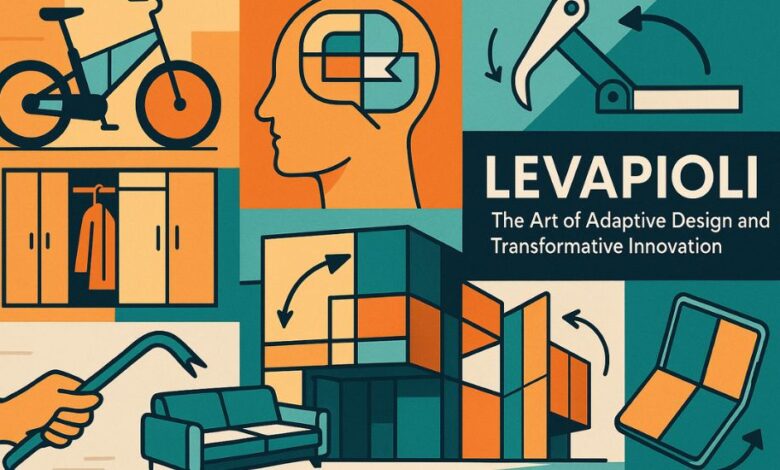Levapioli Thinking: Designing for Flexibility in a Changing World

In a world marked by rapid change, unpredictability, and the blending of disciplines, the concept of Levapioli has emerged as a powerful metaphor and methodology for navigating complexity. Though originally rooted in a physical tool—an Italian device used to lift nails or clips—the term “Levapioli” has been reimagined in recent years as a creative framework for adaptive innovation. It represents flexibility, movement, transformation, and contextual responsiveness. More than just a design trend, Levapioli is becoming a mindset, influencing product innovation, architecture, digital experiences, and organizational thinking.
Origins of Levapioli: From Mechanics to Metaphor
The Italian origin of “Levapioli” stems from the words “leva” (lever) and “pioli” (pegs). As a tool, the levapioli is used to remove nails, clips, or fasteners without damaging the underlying surface—a small yet clever device based on the principle of leverage and precision.
This physical function has inspired a philosophical interpretation. Just like the tool gently removes components without disruption, the Levapioli framework encourages subtle transformation, modular thinking, and non-disruptive adaptability. It’s about adjusting without breaking, shifting without collapsing—an idea increasingly relevant in our fragile and rapidly evolving systems.
Core Principles of Levapioli as a Framework
1. Modular Adaptability
At its core, Levapioli is about designing for change. Systems, products, or environments built using Levapioli thinking are not rigid but composed of modular parts that can be rearranged, removed, or substituted based on context or need.
2. Movement and Transformation
Unlike traditional modular systems that rely on static configurations, Levapioli embraces dynamic movement. Components should pivot, slide, fold, rotate, or expand. This mobility allows for continuous usability in multiple settings and purposes.
3. Context Awareness
A key aspect of Levapioli design is contextual intelligence. Whether it’s a physical object or a digital experience, it must be aware of the environment and user interaction—transforming based on stimuli, behavior, or external changes.
4. Minimal Disruption
Levapioli prioritizes gentle transitions. It seeks to introduce transformation in a way that minimizes disruption, whether in architecture, UX, or business strategy. The goal is subtle evolution rather than abrupt overhaul.
5. Cross-Disciplinary Thinking
The Levapioli framework encourages designers, educators, developers, and strategists to blur the boundaries between disciplines. It thrives at the intersections—where architecture meets technology, or design meets psychology.
Applications of Levapioli in the Real World
🏢 Architecture & Interior Design
Levapioli principles are being used in transformable living spaces, with rotating walls, sliding facades, and folding furniture. These solutions adapt rooms for different functions without needing full renovations. In dense urban environments, this adaptability is vital.
🛠 Product & Industrial Design
Designers are rethinking everyday objects—tools that fold into multiple shapes, desks that transform into shelves, or kitchen appliances that combine several devices into one compact structure. Levapioli-inspired design ensures maximum function with minimal space.
💡 UX & Digital Interfaces
In the tech world, the philosophy manifests in responsive design—apps and websites that reshape their interface based on device, usage patterns, or time of day. It’s also seen in modular app ecosystems, where features can be added or removed seamlessly.
🚲 Urban Mobility
Think of foldable bikes, scooters with collapsing handles, or buses with retractable ramps. Levapioli’s influence on mobility prioritizes portability and transformation, allowing users to adjust their tools to the transportation context.
🧬 Education and Learning Environments
Classrooms designed with Levapioli principles are fluid spaces—desks on wheels, collapsible partitions, and smart boards that pivot. Curricula too are becoming modular, allowing students to customize learning pathways dynamically.
🧠 Organizational Strategy
Businesses are adopting Levapioli mindsets by building agile teams, pivoting business models, and fostering a culture where roles and responsibilities can evolve. Strategic Levapioli thinking helps companies react to market shifts without destabilizing core operations.
Benefits of the Levapioli Framework
-
Increased Efficiency: Adaptable systems reduce resource waste by being multifunctional.
-
Future-Proof Design: Levapioli products or strategies can evolve with time, reducing obsolescence.
-
Sustainability: Reusable, transformable solutions align with eco-conscious goals.
-
User-Centricity: The approach centers around flexibility, which often mirrors real human behavior and needs.
-
Creative Empowerment: Designers and teams gain freedom to explore unexpected solutions.
Challenges in Applying Levapioli
Despite its many benefits, applying Levapioli principles is not without challenges:
-
Engineering Complexity: Designing moving or modular systems often requires greater precision.
-
Cost Implications: Multi-use, transformable products may have higher upfront costs.
-
User Learning Curve: Systems that transform might require user education.
-
Cultural Resistance: Some industries are deeply rooted in static models and may resist dynamic change.
Still, these challenges are far outweighed by the long-term advantages—especially in future-ready sectors.
Levapioli and the Future of Design Thinking
As industries trend toward hyper-personalization, digital fluidity, and climate-conscious innovation, Levapioli’s influence is poised to grow. Future cities, workplaces, and products will be built to shift shape and function, driven by user input, AI prediction, or environmental sensors.
Levapioli thinking will likely lead to:
-
Adaptive clothing that responds to temperature or motion.
-
Transforming workspaces that morph into living spaces in seconds.
-
Smart furniture that self-adjusts based on biometric data.
-
AI-driven architecture that reconfigures based on occupancy and sunlight.
Levapioli in Everyday Life
Even outside high-tech domains, Levapioli thinking can improve daily living. Rearranging your furniture for multifunctional space, organizing your workweek with pivotable priorities, or choosing gadgets with multiple uses are all everyday manifestations of the concept.
Conclusion: Embracing Levapioli
Levapioli is more than a tool or a design method—it’s a way of thinking, a lens through which we can understand how to build for adaptability, flexibility, and resilience. Whether you’re a designer, educator, business strategist, or simply someone navigating an ever-changing world, adopting a Levapioli mindset encourages creativity, preparedness, and a deeper harmony with change.
It’s about seeing structure as fluid, tools as transformable, and systems as alive—ready to shift, respond, and grow as life demands.



